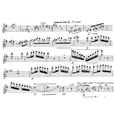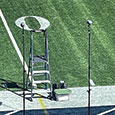Every flutist encounters a passage that is difficult for one reason or another. Five professional flutists share their favorite practice methods for solving those difficult places.
 Ann Marie Yasinitsky
Ann Marie Yasinitsky
My approach to solving technical passages employs changing the rhythms, varying the articulations, and shifting the beamings of the notes. These practice methods are so amazing that I tell my students I will give them their money back if they do not work. I have never had to refund anyone.
To illustrate this method, look at the following excerpt from Chant de Linos by Andre Jolivet at two bars before letter L. Chant de Linos is a powerful tour de force and contains several passages with well-known finger twisters.
Linger and Go
Play the passage lingering on the first note of the triplets. Repeat, lingering on the second note and then finally on the third note of the triplet.
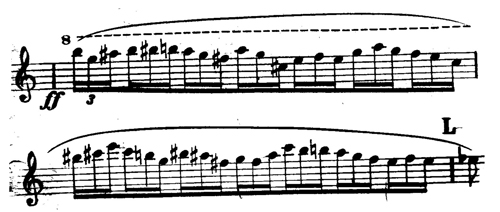
4,3,2,1
This passage is slurred so practice it all tongued. (Conversely if a passage is tongued, change it to all slurred.) First tongue each note four times, double tongued. Repeat tonguing each note three times, then two times, and finally once. This repetitive tonguing has slowed the passage note-wise, and programs the notes and fingerings into your memory. An added bonus is that you will have practiced double and triple tonguing as well.
Next, practice the passage with different articulation patterns of slurring and tonguing. (Slur 2, tongue 2; Tongue 2, slur 2; Slur 3, tongue 1; tongue 1, slur 3 etc.)
Beamings
Since this passage is beamed or grouped in threes, change the beaming to group the notes by fours. Play the first four notes adding a pause after the four notes (chunking). Repeat chunking by fours throughout the passage. Then beam and chunk the passage by fives, sixes, etc. I find that by changing the note groupings, I hear the passage in new ways. It is an interesting and enlightening exercise. It also solidifies the pitches in your ear as well.
After even one practice session, the execution of this difficult passage will be much improved. If practiced this way every day for a week, you will master the passage.
Ann Marie Yasinitsky is Clinical Associate Professor of Flute and Coordinator of Woodwinds at Washington State University. She has performed as a soloist, chamber and orchestral musician throughout the U.S. and Europe and has released numerous acclaimed CDs on various labels including The Musical Heritage Society and Vienna Modern Masters. Yasinitsky was the recipient of a Solo recitalist Grant from the National Endowment for the Arts and received a “Special Commendation” award in the Vienna Modern Master’s International Performers Recording Competition.
* * * *
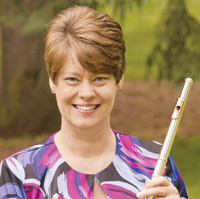 Annette Farrington
Annette Farrington
This year I am fortunate enough to be playing in a really fine community orchestra, the Penfield Symphony Orchestra. Upon receiving the folder of music for the first concert I found it contained none other than Britten’s Young Person’s Guide to the Orchestra. I only had a few weeks to improve the weakest area of my playing – high, fast tonguing. The following excerpt is one that required some careful practice techniques.
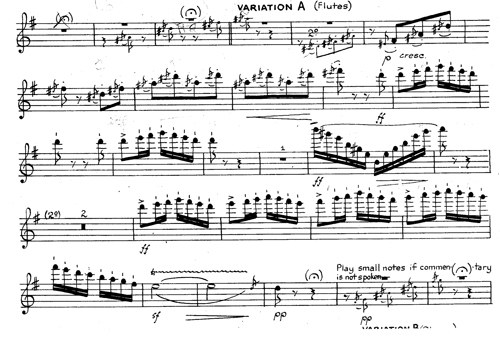
Before working on the excerpt, I began with a good warm-up containing harmonics starting on a fundamental note slurring to the octave, then to the fifth. Since this excerpt is mostly scale patterns, I also played five-note scales, slurred, in the third octave to set the lips and fingers for high note work.
At this point, I turned my attention to the excerpt itself, continuing to slur everything. Beginning in measure 8 of Variation A, at a slow tempo I played each measure separately with rests in between them (chunking), then I added the first note of the next measure to that group, then, finally, playing all the way through to determine the best places to mark the breath. Slurring allowed me to work on tone and concentrate on the amount and speed of air needed for this passage.
At this point, I could no longer avoid the articulation, so I played in chunks again using a breath attack (ha) on each note, followed by a forward tongue stroke (T), then a back tongue stroke (K). My goal was to keep the tone the same as it was while slurring, so occasionally I would return to slurring groups as a reminder for proper air direction. Finally, I played the chunks at a faster pace with double tonguing increasing the tempo on the metronome each time through. After this, I would take a break and come back at a later time to try the excerpt in its entirety again making a note of what still needed work for the next day’s practice session.
I dedicated about 15 minutes on this each day until the performance, and judging by the smiles on the conductor’s face at the end of the piece, all that work must have paid off. I am now looking forward to our less stressful holiday program!
Annette B. Farrington teaches flute at Nazareth College in Pittsford, New York, and has a private studio in Brighton, New York. She frequently performs in the Rochester area and plays with the Penfield Symphony Orchestra, the Perinton Concert Band, the Wilmot Wind Quintet, Cordancia, and the Flower City Society Orchestra. Farrington has been a board member of the Rochester Flute Association serving as President, Newsletter Editor, and Corporate Membership Director.
* * * *
 Cristina Ballatori
Cristina Ballatori
From learning the first scales and arpeggios to refining Taffanel & Gaubert, Reichert, and Moyse exercises, flutists devote many hours working to improve technique. Despite these diligent efforts, all of us encounter difficult or awkward technical passages that drive us to throw up our hands in frustration (and occasionally run through the halls of the practice building screaming). Three of my favorite strategies for tackling these types of passages include transposing the passages at sight, chunking, and a technique I refer to as Read It, Hear It, Feel It, Sing It, and Play It.
Transpose: Make It Harder for Yourself?
Transposing difficult passages up or down by a half step, whole step, or other interval, at sight, is one of the most useful techniques that I have incorporated into my own practice and work with students. If you are not accustomed to transposing, the process of thinking through the transposition of each note in the passage while playing, without transcribing it first, can be very challenging. This technique, like others such as varying rhythms and playing a passage backwards, works well because it allows you to approach the passage from a fresh perspective. This helps you work around and through ingrained blocks while improving facility. After spending time transposing on the spot, a return to the original passage will seem much easier in comparison and problems have often been resolved. The following example from the first movement of Robert Muczynski’s Sonata for Flute and Piano, Op. 14, illustrates this concept.
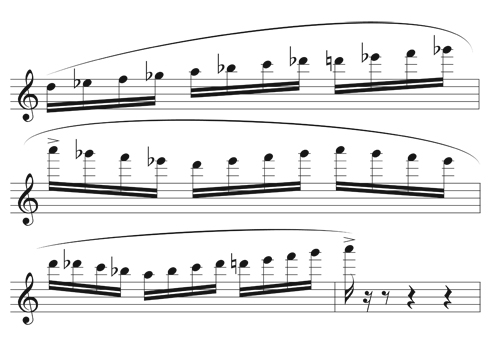
Transpose Up ½ Step
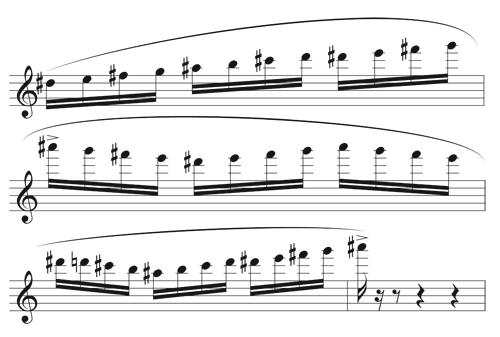
Transpose Down ½ Step
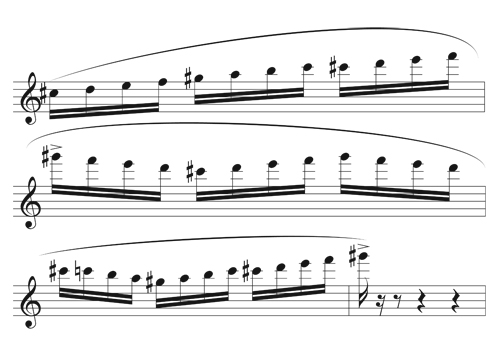
One Note at a Time, One Measure at a Time, One Phrase at a Time
A second technique that is very effective for learning and practicing technical passages is chunking, also known in my studio as the One Note at a Time exercise. Deliberate, focused attention while practicing is especially important in the mastery of difficult technical passages. Too often, flutists blister through technical passages without hearing or thinking about what they are doing; the result is poor accuracy and sloppy technique. This practice method forces you to focus your attention on each note of the passage, taking the time to hear the pitches in your mind’s ear before producing a tone, and imagining the feel of the note in your body before moving the fingers. Experiment with this technique using the previous example.
1. Set your metronome to a comfortable tempo and subdivide in sixteenths, eighths, or quarters.
2. Play downbeat 1 + 2nd note only, followed by a rest.

3. Play downbeat 1 + 2nd, 3rd notes only, followed by a rest
4. Play downbeat 1 + 2nd, 3rd and 4th notes only, followed by a rest
5. Play downbeat 1 + 2nd, 3rd, 4th, and downbeat 2
6. Continue adding one note at a time until you have finished the measure and then add next measure in same way, repeating steps 1-6.
Once you have worked through the exercise adding one note at a time, expand your focus and continue to work adding one measure at a time and one phrase at a time until the passage feels secure.
Read It, Hear It, Feel It, Sing It, and Play It
My absolute favorite technique for learning new music and conquering the most stubborn technical passages is a process that I refer to as Read It, Hear It, Feel It, Sing It, and Play It. Most technical difficulties on the flute are resolved when approached with deliberate effort and critical ears. The process outlined below requires you to do a great deal of sensory work away from the instrument, engaging the brain and ears in a way that repetitive drilling does not.
1. Read through the pitch names in the passage out loud, without pausing or stopping, as if you are reading out loud from a book. When you read through the passage, be sure to say the exact note names as you read them out loud. For example, if you see the pitch “Eb” say “E Flat” out loud when you read this pitch. As you read through the passage out loud, you may find sections that you are unable to read without stumbling. These sections often coincide with points where you encounter difficulty when performing the passage on the instrument. This step provides the opportunity to carefully process what is actually written on the page, helping you to learn the passage accurately the first time while identifying potential problem areas in the passage before you learn them incorrectly on your instrument.
2. Read the pitch names in the passage out loud, without pausing or stopping, while you imagine fingering the notes on the flute and performing them with your most beautiful tone.
3. Read the note names in the passage out loud, without pausing or stopping, while physically fingering the notes on your instrument.
4. Read the note names in the passage out loud while you alternate saying the note names at a piano or forte dynamic and phrasing as if you are having a conversation.
5. Hear the pitches in your mind’s ear as you imagine how it feels to play the notes on the flute.
6. Hear the pitches in your mind’s ear as you physically finger the notes on the instrument.
7. Repeat each of the above steps (1-6) in rhythm with the metronome set at a tempo where you can accomplish each of the steps with accuracy and ease, gradually increasing the speed as you become more confident in your performance of each step.
8. Sing the passage while fingering the notes on your instrument, in rhythm with the metronome.
9. Play the passage on your instrument in rhythm with the metronome.
There are many effective strategies for improving your practice of technical practice. Those outlined above are a few that have worked extraordinarily well for me and my students.
Cristina Ballatori serves as Assistant Professor of Flute at the University of Texas at Brownsville. Her teachers include Alexa Still, Peter Lloyd, Katherine Kemler, Judith Lapple, and Diane Smith.
* * * *
 Cindy Anne Broz
Cindy Anne Broz
Sometimes one stubborn glitch can throw a whole passage off. Once you identify that glitch, you can telescope in and fix that one spot, which might be only 1 or 2 notes. The first step is to identify the problem. If you become accustomed to a passage being problematic, then anticipatory anxiety can build up, distracting your focus through the preceding passages, perhaps even lingering after you have mastered the passage. The second step is to fix the glitch, often resolving the flow of the entire passage. Learn to listen carefully to identify glitches. Sometimes it is quite helpful to have another musician listen, as they might hear a problem that you (playing something highly technical) cannot identify.
Play Fast Passages Like a Ballade
To understand a passage’s melodic contour or horizontal line and express its musicality in a fast piece such as Flash! by Daniel Dorff, play it like a ballade to express the shape and develop phrasing nuances such as subtle dynamic contours or articulation contrasts. When you play a passage slowly, you develop better musical understanding and muscle memory. This ultimately allows you to easily increase the speed of the piece. You also develop phrasing memory through which the little nuances developed at the slow ballade tempo will remain present at the faster concert tempo. This means that you retain musicality rather than merely succeeding at the passagework. Playing a fast technical passage with lyrical expression is the extra dividend of practicing in this manner.
Five Penny
We tend to visualize intervals grouped as the beats or beams fall, sometimes obscuring where the challenging connections are. The 4×4 grouping in bar 143 in the following example leads us to think about the 1st note leading to the 2nd, and the 3rd to the 4th; however, mentally grouping by ascending pairs: C – Db, Ab – Bb, F – Ab, Db – F, etc., may provide a more facile option. Put five pennies on the left side of your stand, and play a difficult passage using different rhythms and articulations. Repeat each variant five times. Each time you play the practice phrase successfully, move a penny from the left side of the stand to the right. If you make a mistake in a particular variant, all the pennies go back to the left side of the stand. This was taught to me by Julius Baker who stated, “There is a speed at which you can play this section accurately. Find that speed, and work it out.”
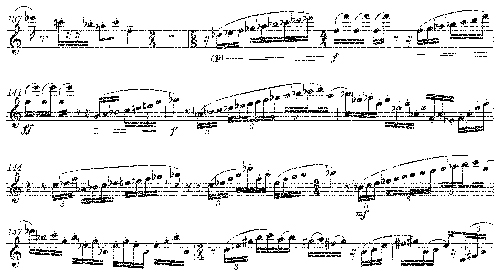
Cindy Anne Broz is an active flutist, piccoloist, and pedagogue based in Southern California. For further information visit: www.cindyannebroz.com
* * * *
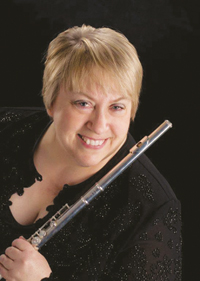 Pam Youngblood
Pam Youngblood
The following passage is measures 89 through 91 of the first movement of the Lowell Liebermann Flute Concerto. The tempo is half note =72. This passage is challenging for several reasons because of the high range of the notes, the quick tempo, the fast tonguing, and the heavy accents.
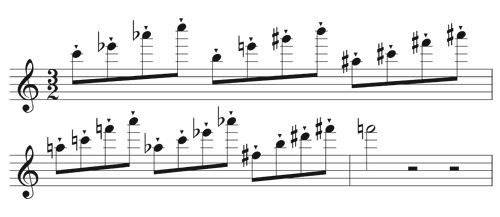
Chunking
To learn the notes, play four notes followed by a rest or pause (Chunking).
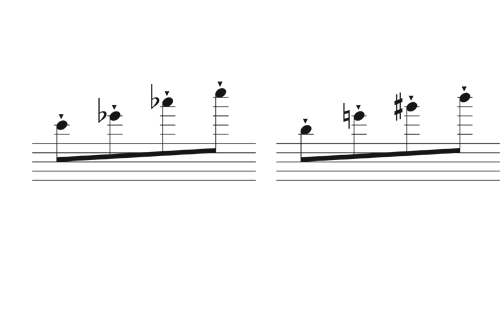
Rhythms
Practice the passage in the following two rhythms to develop fluency of technique.
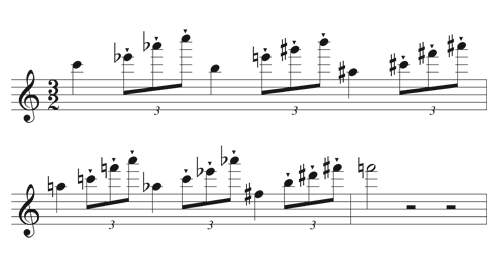
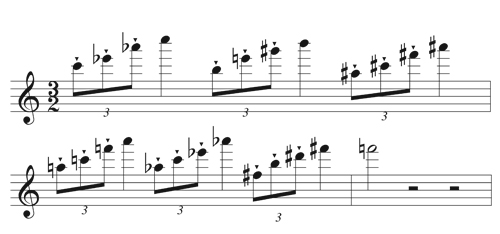
A Chunk Plus One
Practice the four-note chunk adding one more note as a landing note. When starting again after the rest, the previous final note becomes your new first note. This technique facilitates smooth navigation from one group to the next.
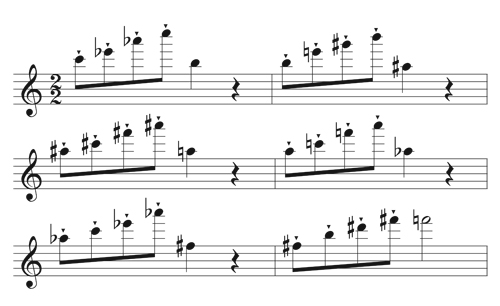
Pam Youngblood is professor and department chair at Texas Woman’s University, principal flutist with the Wichita Falls Symphony, founder and conductor of the Brookhaven and TWU flute choirs, and NFA Professional Flute Choir Coordinator. She has recorded two CDs Wind Song: New American Music for flute and piano and Sparkle and Wit: International Treasures for flute and piano on the Azica label.
Conclusion
As you explore these techniques in your own practice, remember that almost every flutist has the same problem in the same place in the same music. However, the flutist who finds a creative solution to solve this problem will be the one who has a successful concert or audition outcome.
